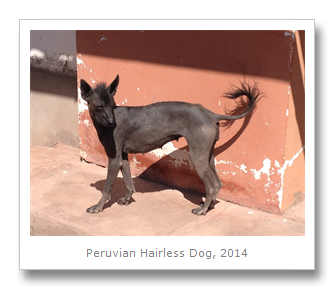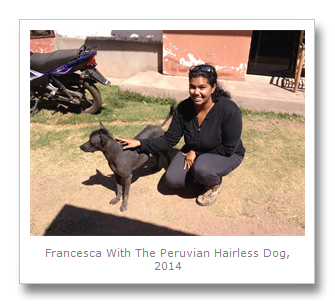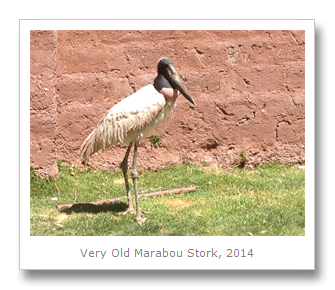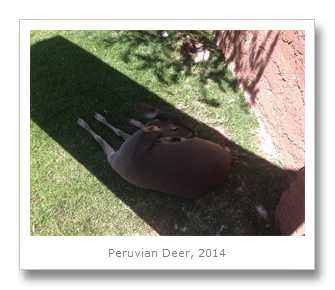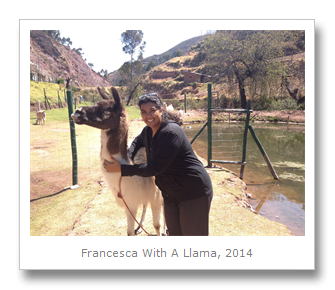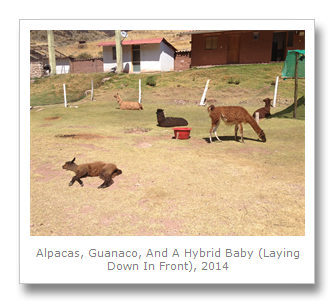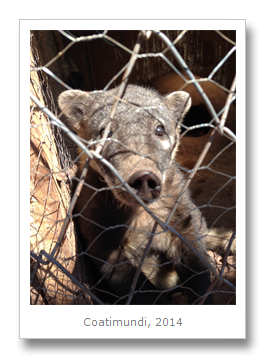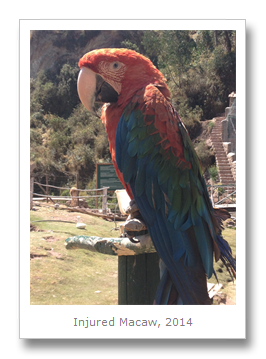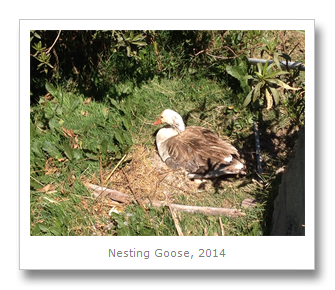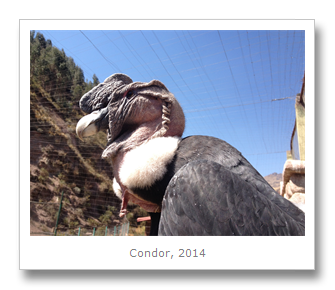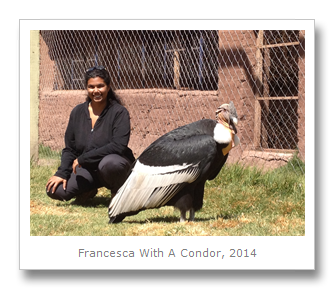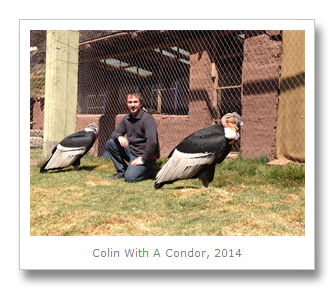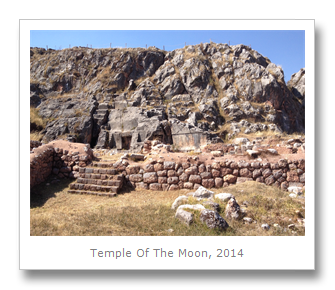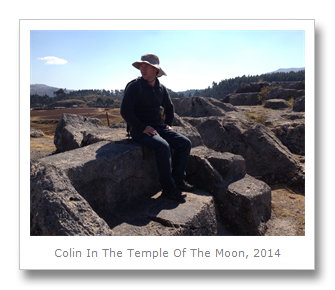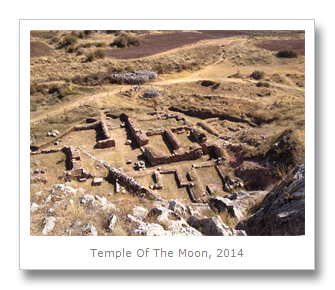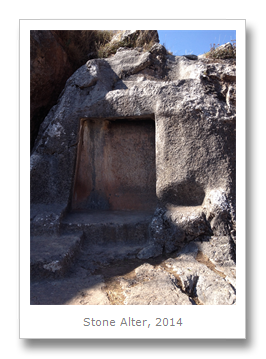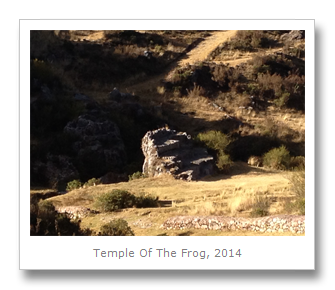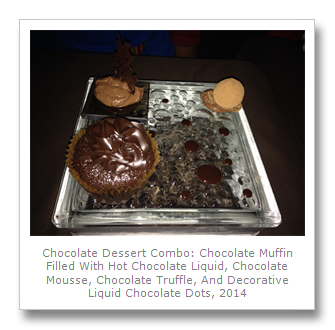On August 14th Colin and I had scheduled to attend a group cooking class put on by the Marcelo Batata Cooking Class at 2:00 PM. This class was run by Chef Erick, and was the one of the best cooking courses we’ve ever done! We started by having a discussion at the cooking class bar on Peruvian food and its’ common ingredients. Erick explained to us that his cuisine is contemporary Peruvian fusion, and uses lots of potatoes, quinoa, chili, and exotic fruits. He showed us a book which had photos of different tubers, roots, fruits, and plants native to Peru. He explained how Peru gets so much great seafood – a product of the Humboldt current bringing sea animals right to the coast.
At this point our group’s first Peruvian amuse bouche (bite sized appetizer) arrived. This treat was a bite of ceviche (Peruvian specialty!) of mahi-mahi, flavored with fish broth and hot chili, then topped with roasted corn and a squeeze of lime. The flavors were fantastic, with the hot chili and lime really working together and the large roasted corn adding a really nice crunch at the end of the bite. Erick told us that it is very important to serve ceviche directly after you make it, as the flavors are quite delicate. Just as we were finishing off the first, a second amuse bouche arrived. This one was guinea pig or “cuy,” cauliflower, Peruvian pickle salad, and a deliciously sweet passion fruit sauce. The guinea pig is another Peruvian specialty, and this single bite was really soft and flavorful – it wasn’t gamey as one might expect from such a strange meat. The passion fruit sauce was really fantastic – I could want that flavor on many different dishes!
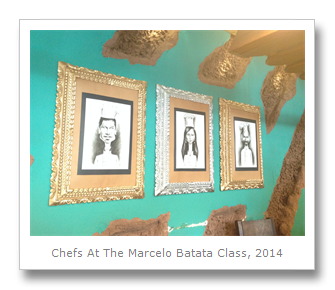
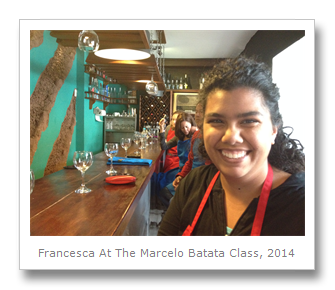
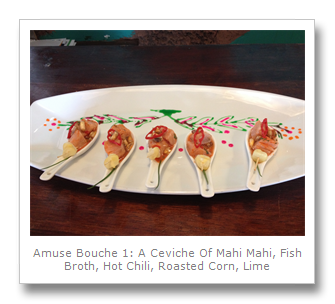

We next headed into a side room which contained examples of items found in typical Peruvian markets. Erick showed us different types of Peruvian tubers (plant roots) including sweet potatoes, yams, oca, yacon, and papalisa, also known as olluco. Many of these tubers are so similar to potatoes that they can be cooked quite the same way. There is even marmalade made out of the yacon type, which is really tasty! Many potatoes are dehydrated in Peru, then months later (sometimes years) rehydrated and cooked. This process increases the potatoes’ starch content (good for times with less food) and makes them taste much more delicious.
Next Erick impressed us with the numerous varieties of quinoa – so many different types than the selection you can find in the USA or Europe. There are many “superfood” seeds in Peru besides the popular quinoa, such as the red-colored kiwicha and the black-colored kaniwa. One of these seeds we were shown was called lupin, and was the focus of our third amuse bouche. This amuse bouche was a nice large dollop of hummus (made with ground tarwi lupin), tahini (sesame seed paste), grilled eggplant, and the whole thing was topped with sesame seeds and served on a mini grilled pita bread. It was creamy, light, and so healthy! Shortly after this healthy amuse bouche came one a little more rich, but just as flavorful. This was my favorite amuse bouche of the evening: a bruschetta covered in a mix made of caramelized tomatoes, smoked bacon, tamarind sauce and topped with slices of sweet orange fruits called aguaymantos. This combination of flavors managed to be both succulently juicy (bacon) and sweet (fruit) – really, really nice.
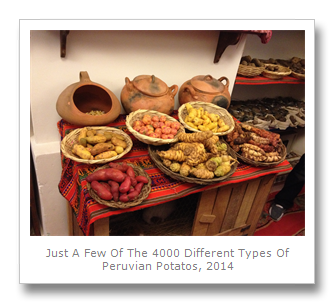
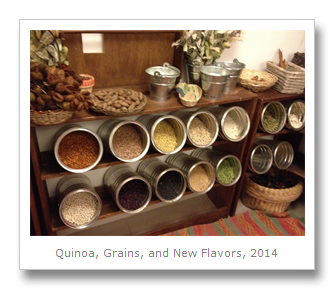

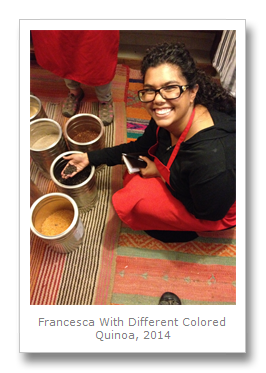
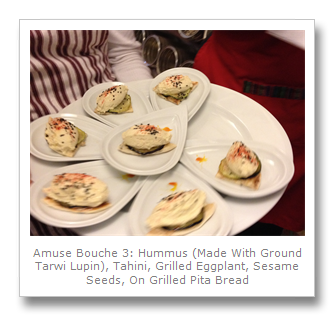
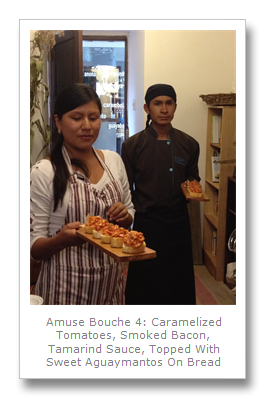
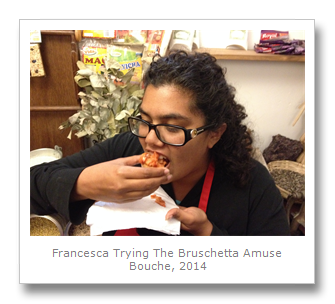
After our little culinary lesson we returned to the bar to find loads of little fruit samples set out for us. We would now experience a fruit tasting of exotic South American and Peruvian fruits such as (left to right in the photo below): aguaymanto, tumbo, maracuya, starfruit, Peruvian grapes, pepino, granadilla, Yacon potato, cactus fruit/tuna, Peruvian mango, cherimoya, and a green fruit called pacay. We formed a little assembly line and took a piece of each fruit to try. My favorite flavors were the passionfruits and the bright orange aguaymanto.
After the fruit we got to have a couple more amuse bouches to try. One of these was a “causa” style amuse bouche made with mahi mahi with corn, potato, and chili sauce. Another amuse bouche was made with huachana sausage (flavored with annatto spices – one of the spices Erick showed us earlier in the market room which is also used as body paint and lipstick by the Peruvians) mixed with onions and garlic and served on top of scrambled eggs. The mix was topped with roasted flack seeds and sesame seeds. The annatto spice really brought out the flavor of the sausage in this one, you really have to try this nutmeg-like spice!
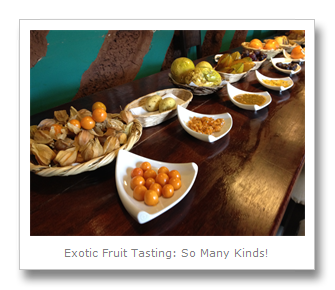
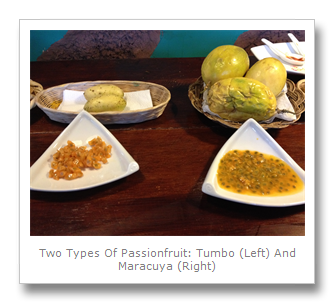
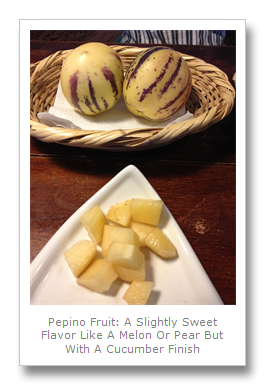
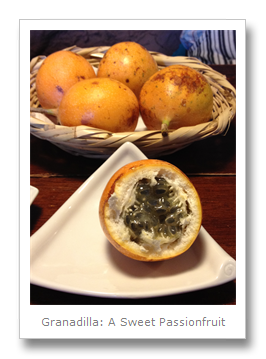
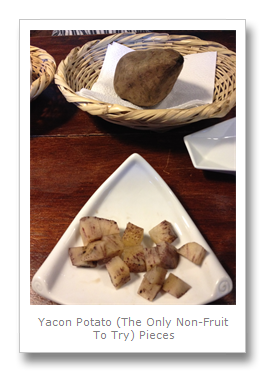
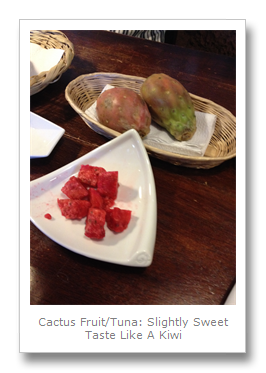
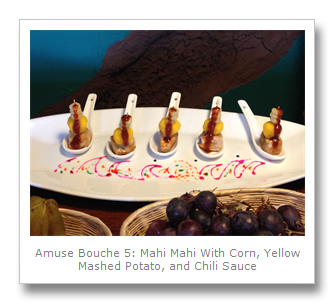
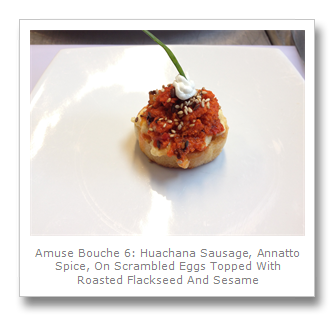
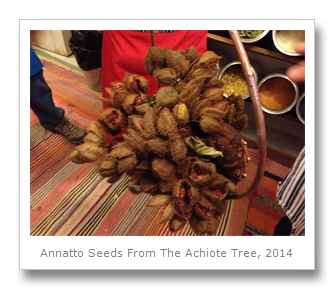
Moving into the cooking room, we each chose stations already outfitted with chopping stations, plates, and everything we needed for preparing our first dish. We would make a Peruvian appetizer called chicken causa, the large version of the mahi mahi amuse bouche we had sampled earlier. Erick guided us through the process, starting with mashing our pre-boiled potatoes to a creamy, soft finish. We then added oil and a yellow pepper sauce to the potatoes and mixed the two in. After a squeeze of lime juice, salt, and pepper came the chopping. Cutting an avocado into slices is not too easy for a beginner, not while trying to avoid mushing them (or eating them) while doing so. But we managed!
At this point everyone else chopped some black olives, but since Colin and I aren’t fans we skipped this addition and only chopped some boiled eggs for ours. Now came the layering of the causa in a small, circular, oiled mold. In between layering the potatoes, shredded chicken, avocado, and eggs, we put dollops of a chili mayo we made to help “hold” it all together and flavor it before a top layer of potato was added. The final step was some decoration – in our case, with tasty colorful oils Erick brought out. This was the best part, as we got to pretend to know what we were doing to make the plate look “fancy!” Finished with our creations, we brought our food back to the bar to enjoy. The dish was so delicious – creamy, sweet, slightly spicy, this appetizer had it! You have to attend the Marcelo Batata cooking class or restaurant to try this.
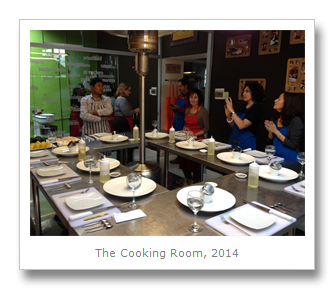
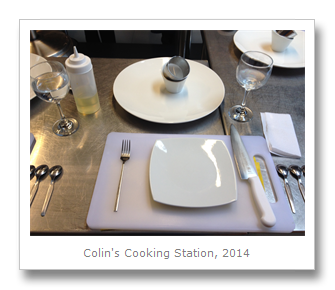
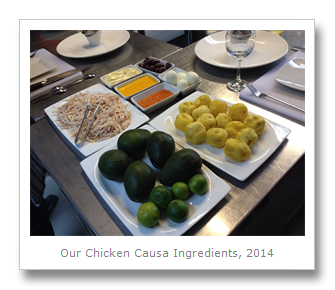
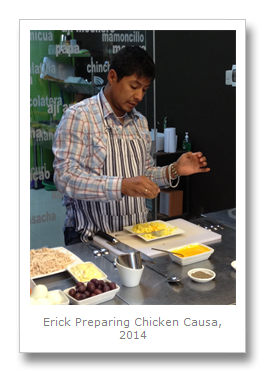
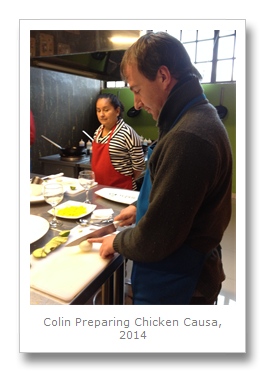

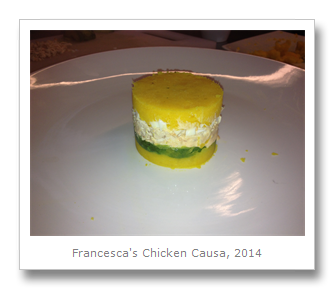
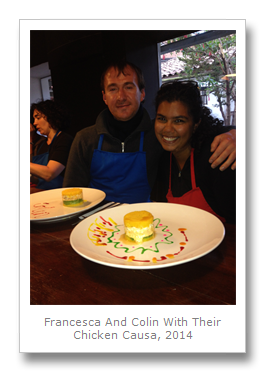
Already at the bar, we began our cocktail class and introduction to Peruvian Pisco liquor and Pisco blends. Next we made a Pisco Sour as a group, with Erick’s guidance. The special ingredient in this drink is egg white – yes, egg white in a drink. We each got to take turns shaking the drink mixer as hard as we could – its trickier than it looks, especially when trying to not *also* shake your head! Colin and I had already had Pisco Sours once, but we hadn’t experienced the next Peruvian drink we made – the chilcano, which is a cool and refreshing mix of ice (to the top of the glass,) lime, 2 shots of pisco, and ginger ale. Each person in the group got to chose which type of drink they wanted to make for themselves after the two example drinks. We each got to chose from various flavor-infused piscos… I opted to mix cherry and lemongrass and Colin went for strawberry and lemon grass. They were different – but both tasty!
As we worked on mixing our drinks we were brought yet another amuse bouche! They just kept coming! This one was more for the sweet tooth in each of us. The delicious hot/cold dessert mix was crispy chocolate-covered wantons stuffed with goat cheese, carrots, purple cabbage, onions, and yellow curry. The warm wontons were served with sweet potato chips dipped in chocolate accompanied by sweet potato ice-cream. One of the most interesting and delicious treats I’ve ever tasted, this is truly a clever creation. Who knew chocolate, veggies, and wontons could go together? And with ice-cream? Just wow… very impressed!
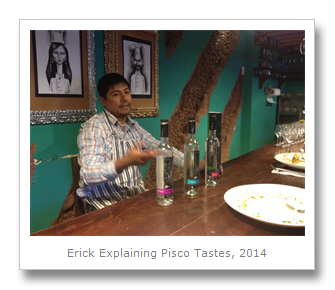
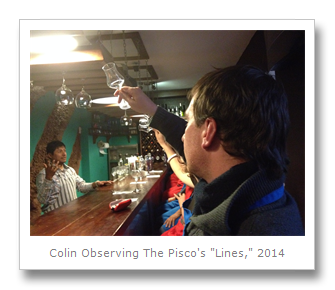

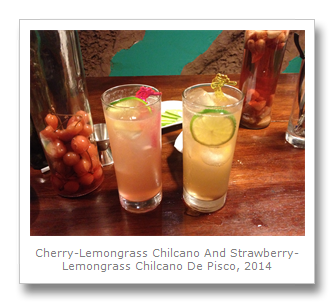
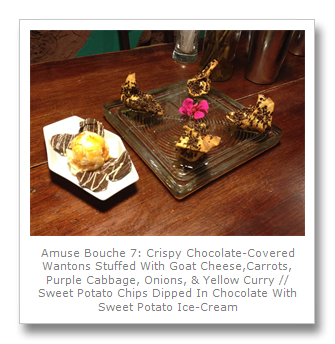
Finally we were at the grand finale: cooking our main course of alpaca saltada. We watched an example – looked a bit intimidating! At one point the pan was lit on fire by adding pisco to the alpaca mix. I had never held a flaming pan before, but Colin was eager to go first and I decided to join him. Our woks over a blaze, we added some oil and started by searing the alpaca meat chunks. Next we added some red onions, red peppers and yellow peppers, garlic, and ginger. We were both encouraged by our group to try flipping our mixture into the air, and after a couple tries (I think a tiny bit of Colin’s ended up on the floor) managed to do it!
That accomplished, it was time for the even trickier part. We added Pisco to the pan and tilted the pan. Up in flames! It was so cool holding a flaming pan for the first time, especially for someone who is not an extraordinary chef! After the flame was gone (silent relief) we added a few swirls of soy sauce and vinegar as a glaze. We plated the alpaca with pre-cooked rice and French fries, then brought our plates into the dining room of the restaurant to enjoy them. Soy sauce and alpaca meat – let me tell you, they really go together! Peruvian fusion is just awesome.
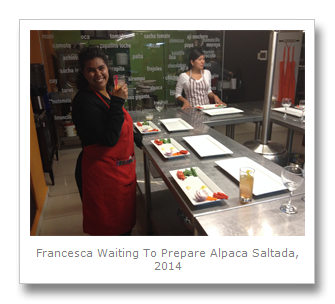
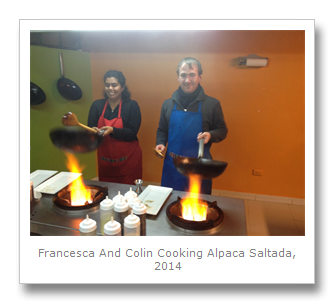
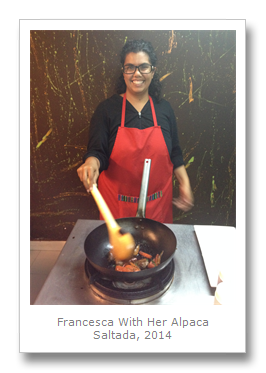
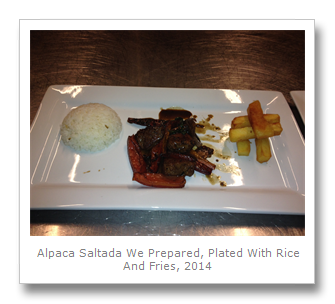
One final surprise was left for us. A chocolate dessert combo to die for: out came an absolutely amazing chocolate muffin which was covered with chocolate icing (almost a cupcake) and filled with a hot chocolate liquid (think “lava cake” but muffin-style)… this muffin alone was a chocolate fantasy. Along with it came a creamy chocolate mousse, a chocolate truffle, and some fun (for dipping!) decorative liquid chocolate dots. I can’t believe after all that food we ended up with even more! And so much chocolate! Our group got to relax with some great conversation while enjoying our Pisco drinks, our alpaca, and our chocolate dessert.
Do not miss this cooking class (or eating at one of Erick’s restaurants) when you visit Cusco! The delicious food is very, very worth it.
Francesca

